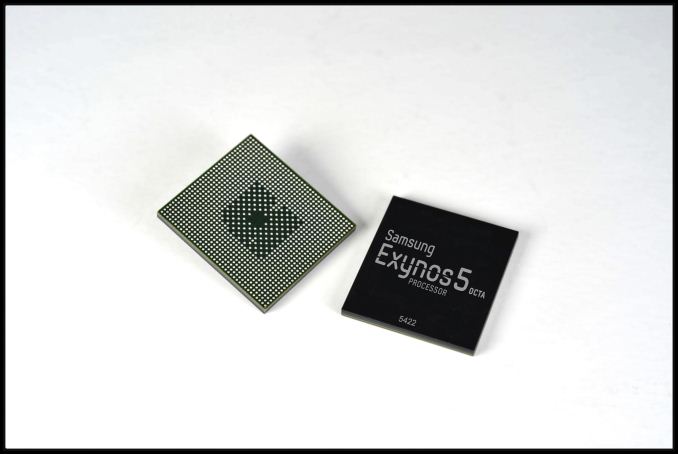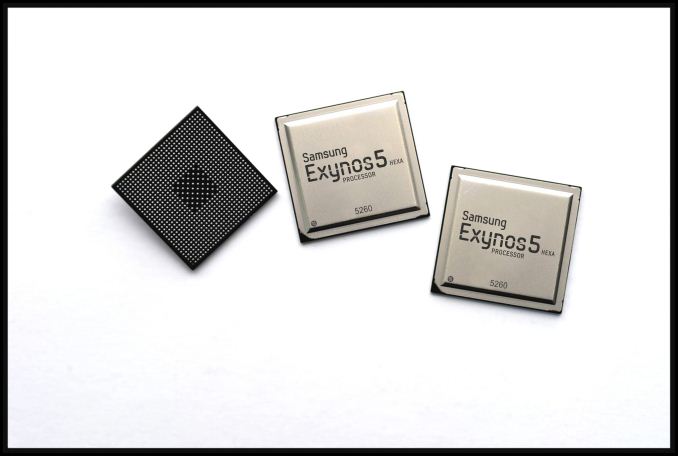Samsung's Exynos 5422 & The Ideal big.LITTLE: Exynos 5 Hexa (5260)
by Anand Lal Shimpi on February 25, 2014 9:00 PM EST- Posted in
- SoCs
- Samsung
- Smartphones
- Mobile
- Tablets
- exynos 5 octa
- Exynos 5 Hexa

Samsung announced two new mobile SoCs at MWC today. The first is an update to the Exynos 5 Octa with the new Exynos 5422. The 5422 is a mild update to the 5420, which was found in some international variants of the Galaxy Note 3. The new SoC is still built on a 28nm process at Samsung, but enjoys much higher frequencies on both the Cortex A7 and A15 clusters. The two clusters can run their cores at up to 1.5GHz and 2.1GHz, respectively.
The 5422 supports HMP (Heterogeneous Multi-Processing), and Samsung LSI tells us that unlike the 5420 we may actually see this one used with HMP enabled. HMP refers to the ability for the OS to use and schedule threads on all 8 cores at the same time, putting those threads with low performance requirements on the little cores and high performance threads on the big cores.
The GPU is still the same ARM Mali-T628 MP6 from the 5420, running at the same frequency. Samsung does expect the 5422 to ship with updated software (drivers perhaps?) that will improve GPU performance over the 5420.
| Exynos 5 Comparison | ||||||||
| SoC | 5250 | 5260 | 5410 | 5420 | 5422 | |||
| Max Number of Active Cores | 2 | 6 | 4 | 4 (?) | 8 | |||
| CPU Configuration | 2 x Cortex A15 | 2 x Cortex A15 + 4 x Cortex A7 | 4 x Cortex A15 + 4 x Cortex A7 | 4 x Cortex A15 + 4 x Cortex A7 | 4 x Cortex A15 + 4 x Cortex A7 | |||
| A15 Max Clock | 1.7 GHz | 1.7GHz | 1.6GHz | 1.8GHz | 2.1GHz | |||
| A7 Max Clock | - | 1.3GHz | 1.2GHz | 1.3GHz | 1.5GHz | |||
| GPU | ARM Mali-T604 MP4 | ARM Mali-T624 (?) | Imagination PowerVR SGX544MP3 | ARM Mali-T628 MP6 | ARM Mali-T628 MP6 | |||
| Memory Interface | 2 x 32-bit LPDDR3-1600 | 2 x 32-bit LPDDR3-1600 (?) | 2 x 32-bit LPDDR3-1600 | 2 x 32-bit LPDDR3-1866 | 2 x 32-bit LPDDR3-1866 | |||
| Process | 32nm HK+MG | 28nm HK+MG (?) | 28nm HK+MG | 28nm HK+MG | 28nm HK+MG | |||
The launch vehicle for the 5422 is likely the recently announced Galaxy S 5. Although most of what we'll encounter will ship with Qualcomm's Snapdragon 801, we'll likely see some international variants with the 5422. It's also entirely possible that some future Exynos 5422 SGS5 variants will feature an Intel XMM 7160 LTE modem.
The more exciting news however is the new Exynos 5 Hexa, a six-core big.LITTLE HMP SoC. With a design that would make Peter Greenhalgh proud, the Exynos 5260 features two ARM Cortex A15 cores running at up to 1.7GHz and four Cortex A7 cores running at up to 1.3GHz. The result is a six core design that is likely the best balance of performance and low power consumption. HMP is fully supported so a device with the proper scheduler and OS support would be able to use all 6 cores at the same time.
The 5260 feels like the ideal big.LITTLE implemention. I'm not expecting to find the 5260 in many devices, but I absolutely want to test a platform with one in it. If there was ever a real way to evaluate the impact of big.LITTLE, it's Samsung's Exynos 5260.
Samsung didn't announce cache sizes, process node or GPU IP for the 5260. Earlier leaks hinted at an ARM Mali T624 GPU. Samsung's release quotes up to 12.8GB/s of memory bandwidth, which implies a 64-bit wide LPDDR3-1600 interface.











35 Comments
View All Comments
Jon Tseng - Thursday, February 27, 2014 - link
But surely if you want 1 big and 3 small cores you could just use CPU migration (the second variant of big.little) without having to go full fat hmp, no?Hmp only adds value if you plan to have 5+cores firing at once, right? But I reckon once you have more than a couple of A15s firing at once you'll get getting into thermal throttling territory anyway in a typical smartphone? (May be diff for tablets)
lilmoe - Friday, February 28, 2014 - link
"Hmp only adds value if you plan to have 5+cores firing at once, right?"Nope. "Ideal" HMP adapts more efficiently, and optimally, to any type workload. HMP is more dynamic than other platforms. If you only need 1 little core, then only one little core is fired up, which is more efficient than, for example, having 1 krait core fired up. If you need 1 big core, then only one is loaded, which (again) is faster than a krait core. That's what I mean by "dynamic". There's only so much optimization you can do to an individual core to handle both light and heavy workloads, having 2 (one optimized for either) gives you a better contrast in power draw.
This, of course, stands IF a chip can power gate each core individually, not only on the cluster level. Don't forget that power draw isn't only dependent on CPU cores, but a platform as a whole (cores, cache, interconnect, bus, RAM, etc..)
Having 4 little cores makes a LOT of sense, since most workloads aren't heavy (most users are on messaging apps and light games), big cores are only needed less than 10% of the time (for most consumers) to generally increase responsiveness of a platform. As far as I undersand, 2 A7 cores draw less power than 1 A15, so loading multiple smaller tasks on MORE little cores should be more efficient than loading multiple tasks on a big core. That said, there are times when loading tasks on big cores is more efficient since they'll be able to be processed significantly faster. This all depends on the type of workload and user habits, that's why designing a kernel that handles all of that isn't an easy task.
Throttling is an issue of any/every high performance core on 28nm, of course, but (again) don't forget that the big cores do more "work" before they get to that point, and the more you have of them, the better when needed, IF the power gating conditions above are met, even if only 1 or 2 of them are needed most of the time during heavy workloads.
There isn't an easy way to describe/explain this. But a less ideal setup (in MOBILE) would be having less small cores than big. Exynos 5422 is the better chip in ideal HMP. It's faster than the 5260, but the 5260 isn't necessarily more power efficient ;) And yes, I don't agree with the author on which is the more "ideal" setup. It all depends on the efficiency of the implemenation and the software/firmware behind all of that at this point.
Wilco1 - Saturday, March 1, 2014 - link
I agree. 2+4 cores is not by definition "ideal" like Anand suggests. If you have 4+4 with HMP then if the workload requires only 2 big cores, it works exactly like 2+4. However you can also fire up 2 extra big cores *if* you need to. Also due to voltage scaling running a workload on 4 big cores at a reduced frequency is far more power efficient than running 2 cores at their maximum frequency.So it is obvious that 4+4 is always better than 2+4, both in terms of performance and power efficiency. However it is also true that 2+4 is good enough (since A15 is fast), and the main reason for it is cost/area optimization for mid-end devices.
gliatiotis - Thursday, February 27, 2014 - link
The 5260 variant is already available inside the Galaxy Note Neo, strangely enough in the LTE one.Systems Analyst - Friday, February 28, 2014 - link
I think that ARM have explained their design philosophy for smart phones; 4 A53s and 2 A57s plus a Mali600. The latter gives hundreds of Gflops/s. No more A57s are needed, because the GPGPU is so powerful. Most benchmarks used, e.g. by Anandtech, appear to be futile, because they do not recognise the use of the GPGPU. According to ARM, Android 4.2 on has supported RenderScript, e.g. on the Google Nexus 10. The Cache Coherent Interconnect supports the GPGPU. This was demonstrated on a stock Nexus 10 in June 2013. ARM and their partners give dozens of use cases for a GPGPU. One use is to provide ISP functionality in software; no ISP hardware required. Another is H.265 in software, again, no special hardware required. This can provide up to 8k resolution, with 2:1 speed-up in compression compared with H.264. There are hundreds of companies working in the ARM ecosphere, and it must be very difficult to follow all developments. Products will gradually appear on the market, and then we will all become more aware of the technical details. Intel do not seem to be competitve. ARM state that they will have 100% penetration of the mobile phone market; we shall see if this is true. The Intel processors for PCs may become redundant, because of these developments. The collosal mobile phone market is driving processor developments, and they will ripple up the processing hierarchy to server farms and HPC.Comparing CPUs is not the point. It is the GPGPUs that count.